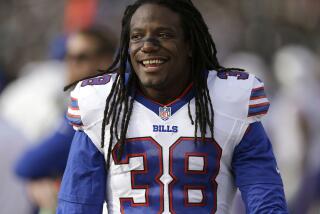Brown Is Making Stunning Recovery
- Share via
DETROIT — In a burst of vigor heartening to a city that has seen more than its share of wounded sports heroes, Reggie Brown sprang from a wheelchair and walked with a confident gait to the podium.
“I’m OK. . . . and I will be back to normal,” Brown said at a news conference at Detroit’s Henry Ford Hospital on Wednesday.
Brown, the Detroit Lion linebacker who suffered a serious spinal injury during a Dec. 21 game, is making a stunning recovery. Doctors said Wednesday that Brown’s prognosis is far rosier than for most people who suffer a similar injury.
He will not play pro football or contact sports again, but he has come far from the frightening moment on the synthetic turf of the Pontiac Silverdome that left millions of fans praying for his life.
Today, Brown, 23, will head to Houston to be with his family and begin rehabilitation.
“I’m looking forward to getting home and getting my life together,” Brown told the visibly moved audience. “I thought I’d never be able to walk again.”
Brown’s recovery probably will take a year, doctors said. The metal halo that keeps his head and spine in place will remain for at least three more months. The motion in his neck will be permanently impaired, and he might not regain complete strength in his hands. Nonetheless, doctors were surprised by his progress.
In terms of recovery, “He is in that upper 2% of patients with that injury,” said Dr. Russ Nockels, director of spine neurosurgery at Henry Ford. “If you asked me what I expected for Reggie last week, I wouldn’t expect this.”
Neurosurgeons use an index to measure motor function in which 100 is the benchmark for a healthy, mobile person. Nockels said Brown was a zero immediately after the accident, 49 in the hospital and is now at 89.
The care Brown received on the field immediately after his injury made the crucial difference, doctors said. He had lost feeling in his arms and legs and could not breathe.
Improper treatment in the first minutes often ends in tragedy for some of the 15,000 people in North America who incur spinal injuries annually. By the time he reached Henry Ford for surgery, the balance had tipped in Brown’s favor,
“It’s almost miraculous, the condition he was transported here,” Nockels said. “They got him to us in a condition we were able to capitalize on.”
The steroid methylprednisolone, a powerful cousin of cortisone, was given to Brown early and in massive doses. This was key to his recovery. In fact, Brown’s total treatment is a textbook case of how a spinal injury should be treated.
“Part of the question this raises is: Shouldn’t everybody be treated like Reggie?” said Dr. Ross Zafonte, medical director of the brain injury unit at Detroit Medical Center’s Rehabilitation Institute. “There’s no reason why they can’t.”
Brown suffered a temporary dislocation of the two vertebrae at the top of his spinal column when he collided with New York Jet offensive guard Lamont Burns. When the vertebrae were jarred, they bruised Brown’s spinal cord.
Any serious spinal injury among the first four vertebrae at the top of the spine can cause breathing loss. Fortunately for Brown, he had an incomplete injury to that region.
Actor Christopher Reeve had a complete injury during a fall from a horse; he now breathes through a ventilator and has no movement below his neck.
Brown’s prognosis was encouraging, especially in light of the fate of other local athletes with life-threatening injuries. Lion offensive lineman Mike Utley was paralyzed during a game in 1991. His sixth and seventh vertebrae were crushed, a complete spinal cord injury. But he has regained most of his upper-body strength and use of his arms and hands.
Last June, Detroit Red Wing defenseman Vladimir Konstantinov and masseur Sergei Mnatsikanov were comatose after their limousine crashed into a tree, Mnatsikanov is not expected to walk again. Konstantinov still has trouble with basic motor skills.
Brown’s surgeons used two two-inch titanium screws to realign his vertebrae. This keeps the vertebrae in place; otherwise they could flap around and cause additional injury. The vertebrae have begun fusing together. Bone grafts were added to make sure the fusion will be permanent.
Brown’s injury was to the central part of his spinal cord and characterized by the weakness in his arms but no major damage to his legs. Among spinal cord injuries, this type offers the best chance of recovery, said Dr. Charles Harvey, a neurosurgeon at St John’s Hospital in Detroit.
“Given the rate of improvement he has shown, I would be cautiously optimistic,” he said. “I have seen patients with similar injuries who have made substantial or nearly complete recoveries.”
Brown will ride a private jet to the Texas Medical Center’s Institute for Rehabilitation and Research in Houston, a nationally ranked center. Brown’s family lives in Texas and he requested to be near them. Henry Ford doctors will talk to him daily to keep tabs on his progress.
His rehabilitation will focus on building strength and coordination in his hands, said doctors. Dr. David Collon, chair of Henry Ford’s orthopedic surgery program and a medical advisor to the Lions, said that while Brown will never play contact sports again, he could coach.
Harvey said it was not unheard of for athletes to shop around for doctors until they find one who will give a green light to play after recovering from a spinal injury.
“Some players earn millions of dollars and don’t want to end their career,” he said. “I don’t think it will happen in Reggie’s case, though.”
More to Read
Go beyond the scoreboard
Get the latest on L.A.'s teams in the daily Sports Report newsletter.
You may occasionally receive promotional content from the Los Angeles Times.










